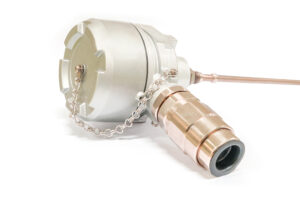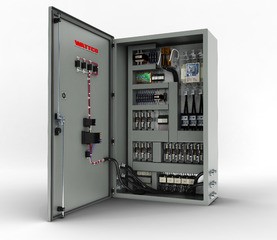What is a Thermocouple, Types of Thermocouples, and What does it do?
Last updated on March 13th, 2024 at 03:36 am
 A thermocouple is a type of temperature sensor made of two wires or alloys of different metals that are linked at one end to form a measuring junction. It produces a voltage proportional to the temperature difference between the measurement junction and a reference junction (often at a known temperature) when subjected to a temperature gradient. In several industrial, scientific, and commercial applications, this voltage is utilised to detect and monitor temperature.
A thermocouple is a type of temperature sensor made of two wires or alloys of different metals that are linked at one end to form a measuring junction. It produces a voltage proportional to the temperature difference between the measurement junction and a reference junction (often at a known temperature) when subjected to a temperature gradient. In several industrial, scientific, and commercial applications, this voltage is utilised to detect and monitor temperature.
How does a Thermocouple work?
A thermocouple is made by joining two distinct metals. After connecting, the metals form two junctions that are subjected to various temperatures. Peltier emf is generated within the circuit by the temperature difference between junctions.
The temperatures at both junctions must be different because equal temperatures result in zero net currents flowing through the circuit. The emf generated in the circuit is determined by the metals used to make the thermocouple.
The thermocouple is connected to a device that measures the emf/current passing through the circuit. It monitors the current flow caused by the temperature differential between the two metals in the thermocouple. The temperature of the reference junction is known, while the temperature of the other connection is unknown.
The circuit’s output is calibrated against the unknown temperature junction. Finally, the thermocouple is used to determine the temperature of the unknown connection.
Because the emf generated in the circuit is so small, highly sensitive sensors are utilised to detect the current. Voltage balancing potentiometers and galvanometers are the most regularly utilised devices.
Types of Thermocouples
The Seebeck effect, which produces a voltage when there is a difference in temperature between two dissimilar metals or alloys, is the basis for the operation of thermocouples, which are temperature sensors. Thermocouples are available in a wide range of varieties, each having unique characteristics and temperature ranges of its own. The different types of thermocouples are as follows:
Type K (Chromel/Alumel):
- Temperature Range: Approximately -200°C to 1,372°C (-328°F to 2,502°F)
- Due to its wide temperature range and accuracy, it is widely used for general-purpose applications.
Type J (Iron/Constantan):
- Temperature Range: Approximately -40°C to 760°C (-40°F to 1,400°F)
- It has good sensitivity and is appropriate for applications requiring lower temperatures.
Type T (Copper/Constantan):
- Temperature Range: Approximately -200°C to 350°C (-328°F to 662°F)
- It is used frequently in cryogenic and biological applications because of its high sensitivity.
Type E (Chromel/Constantan):
- Temperature Range: Approximately -270°C to 1,000°C (-454°F to 1,832°F)
- It is appropriate for a variety of processes, including cryogenics and moderate-temperature ones.
Type N (Nicrosil/Nisil):
- Temperature Range: Approximately -200°C to 1,300°C (-328°F to 2,372°F)
- It provides great accuracy and stability, making it appropriate for a variety of industrial applications.
Type S (Platinum/Rhodium – 10%/90%):
- Temperature Range: Approximately 0°C to 1,600°C (32°F to 2,912°F)
- Used frequently in high-temperature industrial operations and laboratories due to its great precision and stability.
Type R (Platinum/Rhodium – 13%/87%):
- Temperature Range: Approximately 0°C to 1,600°C (32°F to 2,912°F)
- Also used for high-temperature tests, although somewhat different in material composition than Type-S.
Type B (Platinum/Rhodium 30%/70%):
- Temperature Range: Approximately 0°C to 1,700°C (32°F to 3,092°F)
- Suitable for applications requiring extremely high temperatures, such as those found in the metallurgical sector.
Each type of thermocouple has a distinct material composition, temperature range, and sensitivity that makes it suited for a variety of particular applications. To ensure precise and dependable temperature measurements, it’s crucial to take into account elements like the needed temperature range, accuracy, and environmental conditions when choosing a thermocouple for a certain application.
Also read: Thermistor vs Thermocouple.
Where is a Thermocouple used in Industrial Heating?
 For temperature measurement and control in industrial heating applications, thermocouples are widely used. They give up-to-the-minute information on temperature conditions, which is essential for preserving the safety, quality, and efficiency of production processes. The following list includes some typical industrial heating applications for thermocouples:
For temperature measurement and control in industrial heating applications, thermocouples are widely used. They give up-to-the-minute information on temperature conditions, which is essential for preserving the safety, quality, and efficiency of production processes. The following list includes some typical industrial heating applications for thermocouples:
- Kilns and furnaces
The temperature inside furnaces and kilns used in sectors including metallurgy, ceramics, glass manufacture, and heat treatment must be monitored and controlled by thermocouples.
- Industrial Ovens
Industrial ovens are used for a variety of processes, including baking, drying, curing, and annealing, and thermocouples are employed to regulate and maintain accurate temperatures in these ovens.
- Chemical Processing
The temperature of reaction vessels, distillation columns, and other equipment is monitored by thermocouples in chemical manufacturing and processing facilities to verify that chemical reactions take place as intended.
- Oil and Gas Refineries
In refineries, thermocouples are used to measure the temperature of gases, liquids equipment in order to improve operations and uphold safety.
- Power Generation
By keeping track of the temperature of steam, gases, and numerous components, thermocouples play a crucial part in power plants, assuring safe operation of equipment and effective energy production.
- Plastics Processing
Thermocouples aid in maintaining consistent product quality by regulating the temperature of heating components and moulds used in extrusion, injection moulding, and other plastic processing operations.
- Food and Beverage Industry
Thermocouples are used to regulate and monitor temperature in industrial ovens, sterilising apparatus, and food processing equipment to guarantee the quality and safety of the food produced.
- Pharmaceutical Manufacturing
During the drying, mixing, and granulation steps of the pharmaceutical production process, thermocouples are utilised to maintain exact temperature control.
Pros and Cons of using Thermocouples
Due to their benefits, thermocouples often serve as temperature sensors in a variety of fields and applications, but they also have certain drawbacks. The benefits and drawbacks of thermocouples are as follows:
Pros:
-
Wide Temperature Range
Thermocouples are excellent for a variety of applications because they can measure a wide temperature range, from cryogenic temperatures to extremely high temperatures.
- Fast Response Time
Useful for situations where rapid temperature changes need to be monitored or regulated because of their quick response times.
- Durability
They are strong and resistant to mechanical stress and vibration, making them excellent for use in industrial and automotive applications.
- Simple Design
It features a straightforward design with just two wires, making them simple to install and repair as needed.
- Cost-effective
More affordable than other temperature sensors, making them a popular option for applications that are on a tight budget.
- Compatibility
They are compatible with various materials and substances, including liquids, gases, and solids, which makes them useful in a variety of industries.
Cons:
- Accuracy
Its precision is relatively lower than that of thermistors and RTDs (Resistance Temperature Detectors), which are other types of temperature sensors. The type of thermocouple, its age, and the climate can all have an impact on accuracy.
- Non-linearity
A thermocouple’s voltage output and temperature relationship are not linear, which makes the temperature readings more challenging and necessitate more intricate calibration and correction.
- Cold junction compensation
Thermocouples need to be compensated for the cold junction in order to take into account the temperature differential between the measurement point and the reference junction, which is often the instrument. This can make the measurement system more complex.
- Limited sensitivity
As compared to other sensors like thermistors, the limited sensitivity of a thermocouple might be a drawback when high precision is needed.
- Limited Resolution
They may not offer the level of resolution required for extremely accurate temperature measurements due to their reduced sensitivity.
- Interference and noise
The accuracy of temperature measurements can be impacted by interference and noise because thermocouples are subject to electromagnetic interference and noise, particularly in industrial settings containing electrical equipment.
Conclusion
Thermocouples are reliable temperature sensors that are frequently utilised because of their durability and adaptability. In order to measure temperature over a wide range, from cryogenic to extremely high temperatures, they work on the premise of generating a voltage when exposed to temperature fluctuations.
For accuracy to remain high, calibration must be done frequently. Different temperature ranges and uses are accommodated by different thermocouple types. These are used extensively in industrial and scientific contexts due to their reliability and rapid response times, making them essential tools for temperature monitoring and management.
Many industries use Wattco products to achieve their environmental, economic, and production goals. Contact us to discover which products will best help your application and how we can customize it to meet your needs.
